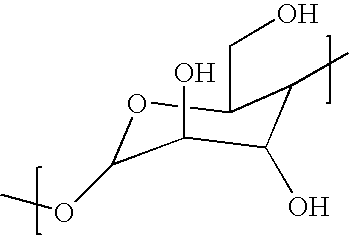Herbicide compatibility improvement
a technology of herbicide compatibility and improvement, applied in the field of herbicide compatibility improvement, can solve the problems of reducing surfactant compatibility, and achieve the effects of improving tank-mix compatibility, reducing surfactant compatibility, and improving tank-mix compatibility
- Summary
- Abstract
- Description
- Claims
- Application Information
AI Technical Summary
Benefits of technology
Problems solved by technology
Method used
Image
Examples
example 1
[0194] Tank mixtures of a commercial glyphosate potassium salt formulation (Roundup® Original Max of Monsanto Company) and a commercial 2,4-D dimethylammonium salt formulation (Agrisolution™ 2,4-D Amine of Agriliance LLC) were simulated by adding the following ingredients in the order shown to a 100 ml Nessler tube, with mixing by inversion:
[0195] 1. 60 ml water, 342 ppm hardness;
[0196] 2. 0-4 ml (see below) 5% aqueous ammonia;
[0197] 3. 5.26 ml 2,4-D formulation;
[0198] 4. water, 342 ppm hardness, q.s. for final volume of 100 ml;
[0199] 5. 3.33 ml glyphosate formulation.
The volumes of ingredients were calculated to simulate a tank mixture for low spray volume (5 U.S. gallons / acre, or about 46.8 l / ha).
[0200] Without addition of aqueous ammonia, flocculation of solids occurred immediately and settled quickly. Solids could be resuspended by agitation, but would not dissolve.
[0201] In presence of up to 1 ml of 5% aqueous ammonia, no improvement in flocculation was observed. With ...
example 2
[0202] Simulated tank mixtures were prepared as in Example 1, but with volumes of ingredients calculated to simulate 10 U.S. gallons / acre (about 93.5 l / ha), as follows:
[0203] 1. 60 ml water, 342 ppm hardness;
[0204] 2. 0-4 ml 5% aqueous ammonia;
[0205] 3. 2.63 ml 2,4-D formulation;
[0206] 4. water, 342 ppm hardness, q.s. for final volume of 100 ml;
[0207] 5. 1.67 ml glyphosate formulation.
[0208] Without addition of aqueous ammonia, no flocculation of solids occurred immediately, but a precipitate appeared after about 1 hour. Precipitation was unaffected by addition of 0.5 ml of 5% aqueous ammonia, but in presence of 1 ml or more ammonia, no precipitation was observed.
example 3
[0209] Tank mixtures of glyphosate potassium salt (Roundup® Original Max) and 2,4-D dimethylammonium salt (Agrisolution® 2,4-D Amine) were simulated by adding the following ingredients in the order shown to a 600 ml beaker, with mixing using a stir plate:
[0210] 1. 366 ml water, 342 ppm hardness;
[0211] 2. 20 ml 2,4-D formulation;
[0212] 3. 13 ml glyphosate formulation.
Heavy precipitation was observed. After a 5 minute period to allow full development of the precipitate, 5% aqueous ammonia was added in 5 ml increments every 2 minutes.
[0213] Redissolution of the precipitate became evident by a degree of clearing of the solution after addition of 20 ml ammonia, but full redissolution required at least 25 ml ammonia. Even then, the solution remained slightly hazy.
PUM
 Login to View More
Login to View More Abstract
Description
Claims
Application Information
 Login to View More
Login to View More - R&D
- Intellectual Property
- Life Sciences
- Materials
- Tech Scout
- Unparalleled Data Quality
- Higher Quality Content
- 60% Fewer Hallucinations
Browse by: Latest US Patents, China's latest patents, Technical Efficacy Thesaurus, Application Domain, Technology Topic, Popular Technical Reports.
© 2025 PatSnap. All rights reserved.Legal|Privacy policy|Modern Slavery Act Transparency Statement|Sitemap|About US| Contact US: help@patsnap.com



